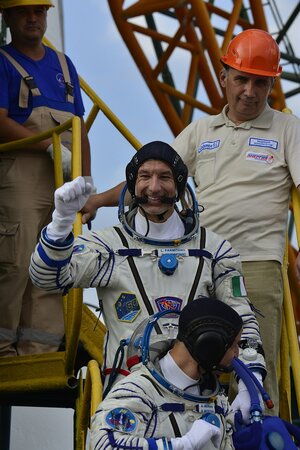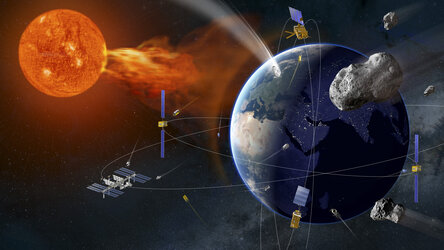Accept all cookies Accept only essential cookies See our Cookie Notice

About ESA
The European Space Agency (ESA) is Europe’s gateway to space. Its mission is to shape the development of Europe’s space capability and ensure that investment in space continues to deliver benefits to the citizens of Europe and the world.
Highlights
ESA - United space in Europe
This is ESA ESA facts Member States & Cooperating States Funding Director General Top management For Member State Delegations European vision European Space Policy ESA & EU Space Councils Responsibility & Sustainability Annual Report Calendar of meetings Corporate newsEstablishments & sites
ESA Headquarters ESA ESTEC ESA ESOC ESA ESRIN ESA EAC ESA ESAC Europe's Spaceport ESA ESEC ESA ECSAT Brussels Office Washington OfficeWorking with ESA
Business with ESA ESA Commercialisation Gateway Law at ESA Careers Cyber resilience at ESA IT at ESA Newsroom Partnerships Merchandising Licence Education Open Space Innovation Platform Integrity and Reporting Administrative Tribunal Health and SafetyMore about ESA
History ESA Historical Archives Exhibitions Publications Art & Culture ESA Merchandise Kids Diversity ESA Brand Centre ESA ChampionsLatest
Space in Member States
Find out more about space activities in our 23 Member States, and understand how ESA works together with their national agencies, institutions and organisations.
Science & Exploration
Exploring our Solar System and unlocking the secrets of the Universe
Go to topicAstronauts
Missions
Juice Euclid Webb Solar Orbiter BepiColombo Gaia ExoMars Cheops Exoplanet missions More missionsActivities
International Space Station Orion service module Gateway Concordia Caves & Pangaea BenefitsLatest
Space Safety
Protecting life and infrastructure on Earth and in orbit
Go to topicAsteroids
Asteroids and Planetary Defence Asteroid danger explained Flyeye telescope: asteroid detection Hera mission: asteroid deflection Near-Earth Object Coordination CentreSpace junk
About space debris Space debris by the numbers Space Environment Report In space refuelling, refurbishing and removingSafety from space
Clean Space ecodesign Zero Debris Technologies Space for Earth Supporting Sustainable DevelopmentLatest
Applications
Using space to benefit citizens and meet future challenges on Earth
Go to topicObserving the Earth
Observing the Earth Future EO Copernicus Meteorology Space for our climate Satellite missionsCommercialisation
ESA Commercialisation Gateway Open Space Innovation Platform Business Incubation ESA Space SolutionsLatest
Enabling & Support
Making space accessible and developing the technologies for the future
Go to topicBuilding missions
Space Engineering and Technology Test centre Laboratories Concurrent Design Facility Preparing for the future Shaping the Future Discovery and Preparation Advanced Concepts TeamSpace transportation
Space Transportation Ariane Vega Space Rider Future space transportation Boost! Europe's Spaceport Launches from Europe's Spaceport from 2012Latest

Beyond mission launch
Thank you for liking
You have already liked this page, you can only like it once!
There is no asking for a better launch date. ESA astronaut Luca Parmitano and fellow Expedition 60/61 crew NASA astronaut Drew Morgan and cosmonaut Alexander Skvortsov lifted off to the International Space Station on 20 July, the 50th anniversary of the historic Apollo 11 Moon landing.
While others were attending anniversary events or pouring through memorabilia, Luca was strapped in the most reliable spacecraft to ferry humans back and forth to space.
The Soyuz MS-13 lifted off from Baikonur cosmodrome in Kazakhstan at 18:28 CEST. After orbiting Earth four times in a span of six hours, the Soyuz docked to the Russian Zvezda module at 00:48 CEST on 21 July. After leak checks, the hatch opened at 3:04 CEST.
Luca is no stranger to spaceflight. His first mission to the International Space Station was in 2013 for the Volare mission. In mission Beyond, Luca will stay another six months and conduct a range of science experiments, extravehicular activities or spacewalks, technology demonstrations and education outreach activities.
In an exciting first for Luca, he will take over command of the Station during Expedition 61 when current Station commander cosmonaut Alexei Ovchinin returns to Earth. This is the third time a European astronaut will assume the role, after ESA astronauts Frank de Winne of Belgium and Alexander Gerst of Germany.
The Moon is still very much the focus of space activities and Luca will work on experiments designed to aid the future of space exploration.
These experiments include BioRock, which aims to understand whether microbes used to ‘biomine’ on Earth could also work on other planetary bodies, and to examine how communities of microorganisms grow on rocks in space.
Luca will test and operate ESA’s Life Support Rack, designed to recycle carbon dioxide into breathable oxygen as part of ESA’s goal to enable astronauts to live independently from Earth on a sustainable basis. He will also drive a rover on Earth from the International Space Station testing remote operations that could be applied on the Moon.
Results from these experiments will support ESA’s contribution to the lunar Gateway and the Heracles mission to the Moon in ongoing work with international partners.
In addition to the science he will carry out onboard, Luca has also been preparing to step out into space, working with teams on the ground to develop new procedures and tools to repair the Alpha Magnetic Spectrometer (AMS-02).
Installed outside the Space Station in 2011, AMS-02 is a particle physics detector collecting cosmic rays to help scientists understand dark matter. It was initially only meant to operate in space for three years, but it was so successful in its mission that its life has been extended. To enable this to happen, three of its four cooling pumps require repair in a challenging spacewalk.
Follow #MissionBeyond on social media, the blog, and on the newly launched podcast ESA Explores for exciting updates over the next six months.
-
CREDIT
ESA - S. Corvaja -
LICENCE
ESA Standard Licence

Intense ‘Beyond’ mission for Luca

Luca Parmitano performs the traditional door signing…

On the way to the rocket

Soyuz MS-13 crew give a final wave















 Germany
Germany
 Austria
Austria
 Belgium
Belgium
 Denmark
Denmark
 Spain
Spain
 Estonia
Estonia
 Finland
Finland
 France
France
 Greece
Greece
 Hungary
Hungary
 Ireland
Ireland
 Italy
Italy
 Luxembourg
Luxembourg
 Norway
Norway
 The Netherlands
The Netherlands
 Poland
Poland
 Portugal
Portugal
 Czechia
Czechia
 Romania
Romania
 United Kingdom
United Kingdom
 Slovenia
Slovenia
 Sweden
Sweden
 Switzerland
Switzerland
























